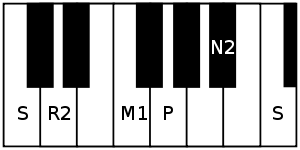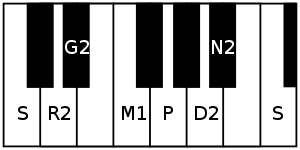Shree (Carnatic raga)
Shri ragam is an ancient ragam in the Carnatic tradition. It is also written as Sri or Shree.[1] This scale does not have all the seven swaras (musical notes) in the ascending scale.[1] Shree is the asampurna melakartha equivalent of Kharaharapriya, the 22nd Melakarta rāgam.[1][2] It is the last of the 5 Ghana rāgams of Carnatic music.[1] It is a popular rāgam that is considered to be highly auspicious.[2]
| Arohanam | S R₂ M₁ P N₂ Ṡ |
|---|---|
| Avarohanam | Ṡ N₂ P M₁ R₂ G₂ R₂ S |
| Carnatic music |
|---|
Tanjavur-style Tambura |
| Concepts |
| Compositions |
| Instruments |
|
Notably, Carnatic Shree takes the lower madhyamam being the asampurna scale equivalent of Kharaharapriya. It is not related to the Hindustani raga, Shree.
Structure and Lakshana


Shree is an asymmetric rāgam that does not contain gāndhāram or dhaivatam in the ascending scale. It is a audava-vakra-sampurna rāgam (or owdava, meaning pentatonic in ascending scale),[1] where vakra indicates the zig-zag nature of jumping notes in descending scale. Its ārohaṇa-avarohaṇa structure (ascending and descending scale) is as follows (see swaras in Carnatic music for details on below notation and terms):
- ārohaṇa: S R₂ M₁ P N₂ Ṡ[lower-alpha 1]
- avarohaṇa: Ṡ N₂ P M₁ R₂ G₂ R₂ S[lower-alpha 2] (or) Ṡ N₂ P D₂ N₂ P M₁ R₂ G₂ R₂ S[lower-alpha 3]
This scale uses the notes chatushruti rishabham, sadharana gandharam, shuddha madhyamam, panchamam, chatushruti dhaivatam and kaisiki nishadam.
Popular compositions
Shree rāgam has been decorated with compositions by many composers. A few of the popular kritis are listed here.
- The fifth Pancharatna Kriti Endaro mahanubhavulu composed by Tyagaraja in Telugu, the last of the 5 gems
- Sami ninnekori, a Varnam by Karur Devudu Iyer in Telugu
- Nama kumusumamula by Tyagaraja in Telugu
- Yuktamu gAdu by Tyagaraja in Telugu
- Sri Varalakshmi, Sri Muladhara chakra vinayaka , Sri Kamalambike and Sri vishvanatham bhaje by Muthuswami Dikshitar in Sanskrit
- Bhavayami Nanda and Reena Madadritha by Swathi Thirunal
- Karuna Cheyvan Enthu by Irayimman Thampi
- Karuna judu ninnu by Shyama Shastri in Telugu
- Mangalam arul by Papanasam Sivan in Tamil
- Vande Vasudevam by Annamacharya in Sanskrit
- Mayanai part of the Thiruppavai by Andal
- Vanajasana Vinuta composed by Subbaraya Shastri in Telugu
Film Songs
Language: Tamil
| Song | Movie | Composer | Singer |
|---|---|---|---|
| Deviyar Iruvar | Kalai Kovil | Viswanathan–Ramamoorthy | P. Susheela |
| Sandanathil Nalla Vasam Eduthu | Praptham | M. S. Viswanathan | T. M. Soundararajan, P. Susheela |
| Sugamana Ragangale(Pallavi only) | Miruthanga Chakravarthi | Vani Jairam | |
| Enni Irundhadhu | Antha Ezhu Naatkal | Malaysia Vasudevan, Vani Jairam | |
| Solam Vidhakayile | 16 Vayathinile | Ilayaraja | Illayaraja |
| Saamakozhi Koovudhamma | Ponnu Oorukku Pudhusu | Ilayaraja, S. P. Sailaja | |
| Theendai Mei Theendai | En Swasa Kaatre | A. R. Rahman | S. P. Balasubramaniam, K.S. Chitra |
| Selai Kattum | Kodi Parakuthu | Hamsalekha | |
| Kaakai Chiraginile | Purusha Lakshanam | Deva | |
| Manase Manase | Nenjinile | P. Unnikrishnan, K.S. Chitra | |
| Cochin Madapura | Unnudan | P. Unnikrishnan, Swarnalatha | |
| Suttipoove | Kaivantha Kalai | Dhina | Karthik, Sadhana Sargam |
| Sinthamani Sinthamani | Aahaa Enna Porutham | Vidyasagar | Hariharan, S. Janaki |
| Thodu Thodu Vaa Mella | Dharma Devathai | Raveendran | K.J. Yesudas, S. Janaki |
| Pooncholai Kiliye | Aran | Joshua Sridhar | Karthik, Asha G. Menon |
Related rāgams
This section covers the theoretical and scientific aspect of this rāgam.
Scale similarities
- Madhyamavati is a rāgam which has a symmetric ascending and descending scale, which matches the ascending scale of Shree. Its ārohaṇa-avarohaṇa structure is S R2 M1 P N2 S : S N2 P M1 R2 S
- Manirangu is a rāgam which has gāndhāram in the descending scale, while all other notes in both the ascending and descending scale are same as Madhyamavati. Its ārohaṇa-avarohaṇa structure is S R2 M1 P N2 S : S N2 P M1 G2 R2 S
Notes
- Alternate notations:
- Hindustani: S R M P Ṉ Ṡ
- Western: C D F G B♭ C
- Alternate notations:
- Hindustani: Ṡ Ṉ P M R G̱ R S
- Western: C B♭ G F D E♭ D C
- Alternate notations:
- Hindustani: Ṡ Ṉ P D Ṉ P M R G̱ R S
- Western: C B♭ G A B♭ G F D E♭ D C
References
- Ragas in Carnatic music by Dr. S. Bhagyalekshmy, Pub. 1990, CBH Publications
- Raganidhi by P. Subba Rao, Pub. 1964, The Music Academy of Madras